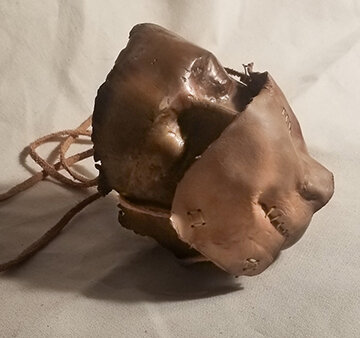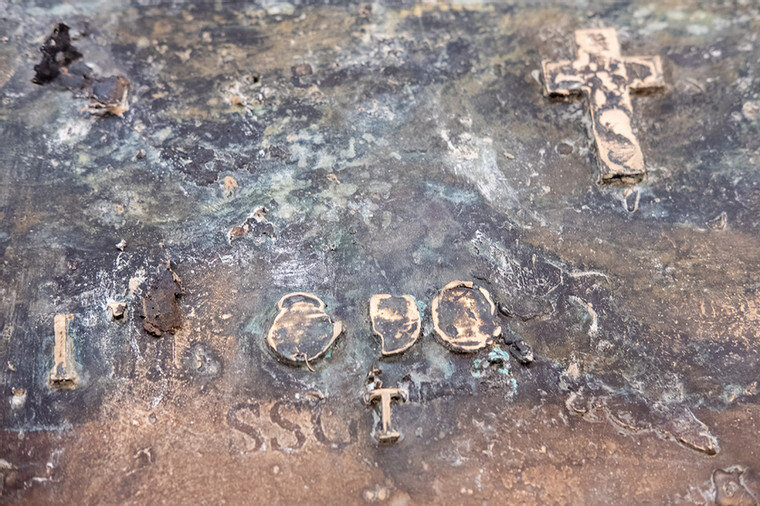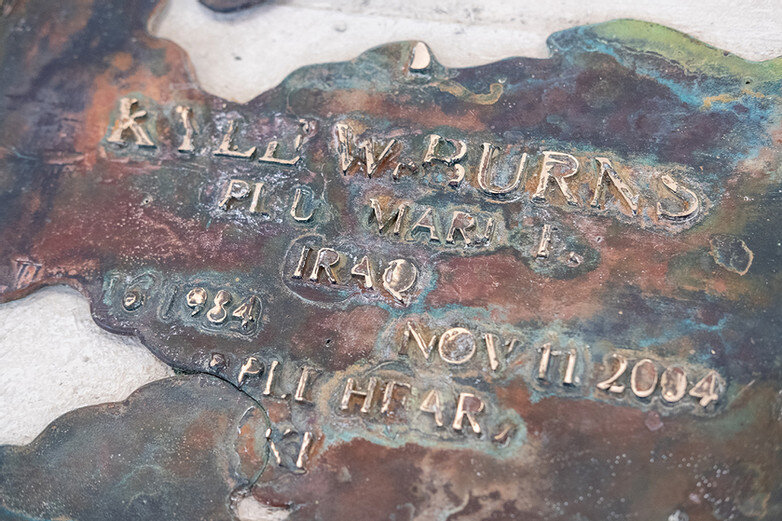james cahill
My Guardian Angel (2020)
Leather, artificial sinew. 8Wx4Hx>1D (inches).
For purchase inquiries please contact the artist at jcahill655@yahoo.com
For more about this artist, visit www.jamescahillart.com
My Guardian Angel, alternate view. Leather, artificial sinew. James Cahill, 2020. All Rights Reserved.
Detail of Installation Your 2 Cents by James Cahill.
All Rights Reserved.
Detail of Installation Your 2 Cents by James Cahill. All Rights Reserved.
Detail of Installation Your 2 Cents by James Cahill. All Rights Reserved.
Detail of Installation Your 2 Cents by James Cahill. All Rights Reserved.
Detail of Installation Your 2 Cents by James Cahill. All Rights Reserved.
Detail of Installation Your 2 Cents by James Cahill. All Rights Reserved.
Detail of Installation Your 2 Cents by James Cahill. All Rights Reserved.
Artist’s statement
Every stitch and every mark have meaning to me. So ultimately my practice is for me, but one of the best parts is watching others’ reactions to my work, and then engaging with them. If nothing else, knowing I challenged someone's perception is great. During the time of Covid-19, engagement is
next to impossible. This isolation is breaking down the very essence of our society. Adding insult to injury, on the rare outing, I am unable to see others’ faces. This immediately removes a large portion of their humanity as they are now a faceless mass.
By 2120, one hundred years of masked barbarism will reduce humanity into two groups. People who have seen your face, and everyone else. New value is added to what is uniquely ours, caused by how rare people expose their faces. Some would exploit this value by hiding their faces behind the faces of others.
Dehumanization combined with societal breakdown is a recipe for barbarism.
About the Artist
The Babel Masks is proud to introduce James Cahill in his first public exhibition. Cahill studies art at California State University, Chico, with a focus on bronze casting. He works in other media as well, including sewing, quilting, textiles, and leather. He is studying sculpture under Lauren Ruth and
Trevor Lalaguna. Cahill originally came to Chico to study engineering, but he also enrolled in a sculpture class. After attending an artist friend’s bronze pour, he enthusiastically switched majors.
A Marine veteran, Cahill’s recent installation and performance work at CSU Chico, Your 2 Cents, marked the 15th anniversary of the deaths of his friends stationed with him in Iraq. The work features grave markers honoring those soldiers. Shepherding this work to fruition led to a keen interest in the community aspects of performance and installation, which Cahill aims to explore in future work. He frequently donates rather than sells his work to support different charities.
Cahill has faced many struggles in his life. As a youth, he coped with homelessness. After 9/11 he served two tours in Iraq, where he endured the loss of friends. He also struggled, in sorrow, with the loss of a child and, subsequently, the end of his marriage. Now a disabled veteran, Cahill finds his trials and experiences have strongly influenced his approach to his practice, and so he finds that his process is at least as important as the resulting work.
Feature Article
James Cahill was our featured artist for April 14-20, 2021. We will feature a new artist of the Babel Masks Ad-Hoc Collective each week.
10 questions
1. Was sculpture your first love, or did you come to it from other media?
Sculpture is really my only love. Other media feels contrived to me, where sculpture adheres to the very same laws of nature that we do. This makes it more tangible and by extension more relatable for me. When I look at a painting, I often wish I was there. With sculpture I am there.
2. In your artist’s bio, you write that you are a Marine veteran. Can you tell us how you decided to become an artist after your time in the military?
It was really nothing more than happenstance. I had several disastrous attempts to finish my education in engineering. When I got to Chico, my partner took me to a bronze pour at CSU Chico. I was so enamored with it I immediately changed my whole schedule and major. Casting checked every box for me, and my horizons expanded from there. Before that, I had next to no artistic ability, and nuance has never been natural to me. So I have come a long way in a short time.
3. You write in your bio that you are familiar with struggle and loss and that this has strongly influenced your approach to your practice. What are some of the aspects of your practice that you notice are unique to you?
I constantly evaluate, destroy, create, and modify in an effort to learn, grow and improve.This is the heart of who I am. So by nature all of my practices are in a state of flux. Often I will adjust or scrap ideas on the fly. Other times growth will be achieved through reflection. While working I often appear as the embodiment of chaos; however, my inner dialogue is structured and orderly.
4. In your bio, you mention that you are a disabled veteran. What can you tell us about the way disability informs art – or to put it another way, how do you create a path in a profession that often overlooks disabled artists? What changes do you think the art world can make to create a space for them and their work?
There is no guarantee in life, not even for the next day. This means that while I can plan for tomorrow, I have to be accepting of the here and now. I accept that the person I once was died in Iraq. I accept that I am different from others, and it shows. I accept that nobody is going to give me a break. I accept that the fine art world won’t change for me. To accept is to see with clarity, without judgment. Acceptance is the only path to understanding. Understanding is the only path to enact meaningful change.
Judgment is trying to make the data fit the hypothesis; it is a bias you are seeking to prove. It is the enemy of truth, because it only allows you to see what you want to see. We can minimize judgment if we sincerely seek truth, no matter the cost. The problem here is that the nature of truth is a cold objectivity, which can appear cruel.
Considering your question, I don’t see a single problem with a simple solution. I see many systemic problems having to do with society at large. So rather than trying to fix society in a single statement, I just explain the basis of my understanding of how to solve a problem.
5. What are your present goals for your art in your community?
Currently, I am migratory, and I don’t know where I am going to end up. With that in mind, I would like to get more veterans into arts. There aren’t many of us, which is sad considering how much this can help.
6. Of your practice, you write in your artist’s statement, “one of the best parts (of making art) is watching others’ reactions to my work, and then engaging with them.” Can you say more about the ways you see others engage with your work and the way they engage with you?
Most people have walls and barriers up. This is hard for me to understand. My barriers are pretty light if any, because I see such barriers as obscuring the truth. Barriers are why it takes so long to get to know anyone, why things can become so difficult. So I take a little bit of delight in tearing down walls, exposing someone for who they really are. Even if for only a moment, it is a moment of pure truth and honesty. It is really a beautiful thing.
7. How has the pandemic changed or affected your artistic practice? What do you see happening to the community around you?
For me personally, my practice came to an abrupt halt. Due to financial circumstances, I couldn’t keep anything going apart from drawing. I still feel fortunate to have gotten out of homelessness in only a few weeks. So many others have not been so fortunate.
Art communities in California have been in a time of flow, but with the lockdowns the ebb has arrived. Art will become more lean, but the people and groups who stick through it will be better for it. Despite popular opinion, these times aren’t unprecedented, and the cycle will continue.
8. You mentioned in your statement that you have developed a keen interest in performance and installation. How do you hope to incorporate this into your practice moving forward?
The problem with performance and installation is that both exist in the public realm. I largely suspect that even if things went 100% back to normal tomorrow, people would still be suspicious of each other. So with this in mind, I have been brainstorming work designed for community building; not just the art community, but the community as a whole. I have several large hurdles to cross, and they may prove insurmountable. Ironically, I am trying to build a community I have never felt I was a part of.
9. Who have been your influences – what artists, teachers or role models have made a strong impression on you?
Artistically speaking, Trevor Lalaguna, Dave Barta, Lauren Ruth, and Sherri Simons, all in the sculpture department at CSU Chico. Every single one of them has taught me that I can consider myself an artist. They are some of the best educators I have ever met. More importantly, they complement each others’ approach quite well, and they function very well as a unit.
10. If you could give advice to an artist who has just started their career, what would you say to them? What do you wish someone had told you when you started out?
Very few people are willing to take risks. Worse yet, most won’t even leave what is comfortable. Face fears directly. Do what makes you uncomfortable. Remember, comfort breeds complacency. Complacency leads to stagnation. Stagnation is the death of the soul.








